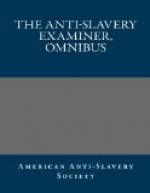faith,” is that “
slavery still continues
in those states,”—thus admitting,
that if slavery did
not “still continue”
in those States, Congress could abolish it in the
District. The same admission is made also in the
premises, which state that slavery existed in
those states
at the time of the cession, &c.
Admitting that if it had not existed there then, but
had grown up in the District under United States’
laws, Congress might constitutionally abolish it.
Or that if the ceded parts of those states had been
the
only parts in which slaves were held under
their laws, Congress might have abolished in such a
contingency also. The cession in that case leaving
no slaves in those states,—no “good
faith” would be “implied” in it,
nor any “violated” by an act of abolition.
The resolution makes virtually this further admission,
that if Maryland and Virginia should at once abolish
their slavery, Congress might at once abolish it in
the District. The principle goes even further
than this, and
requires Congress in such case
to abolish slavery in the District “by the
good
faith implied in the cession and acceptance of
the territory.” Since, according to the
spirit and scope of the resolution, this “implied
good faith” of Maryland and Virginia in making
the cession, was, that Congress would do nothing within
the District which should counteract the policy, or
discredit the “institutions,” or call
in question the usages, or even in any way ruffle
the prejudices of those states, or do what
they
might think would unfavorably bear upon their interests;
themselves of course being the judges.
But let us dissect another limb of the resolution.
What is to be understood by “that good faith
which was IMPLIED?” It is of course an admission
that such a condition was not expressed in the
acts of cession—that in their terms there
is nothing restricting the power of Congress on the
subject of slavery in the District. This “implied
faith,” then, rests on no clause or word in the
United States’ Constitution, or in the acts
of cession, or in the acts of Congress accepting the
cession, nor on any declarations of the legislatures
of Maryland and Virginia, nor on any act of
theirs, nor on any declaration of the people
of those states, nor on the testimony of the Washingtons,
Jeffersons, Madisons, Chases, Martins, and Jennifers,
of those states and times. The assertion rests
on itself alone! Mr. Clay guesses that
Maryland and Virginia supposed that Congress
would by no means use the power given them
by the Constitution, except in such ways as would
be well pleasing in the eyes of those states; especially
as one of them was the “Ancient Dominion!”
And now after half a century, this assumed expectation
of Maryland and Virginia, the existence of which is
mere matter of conjecture with the 36 senators, is
conjured up and duly installed upon the judgment-seat
of final appeal, before whose nod constitutions are
to flee away, and with whom, solemn grants of power
and explicit guaranties are, when weighed in the balance,
altogether lighter than vanity!




